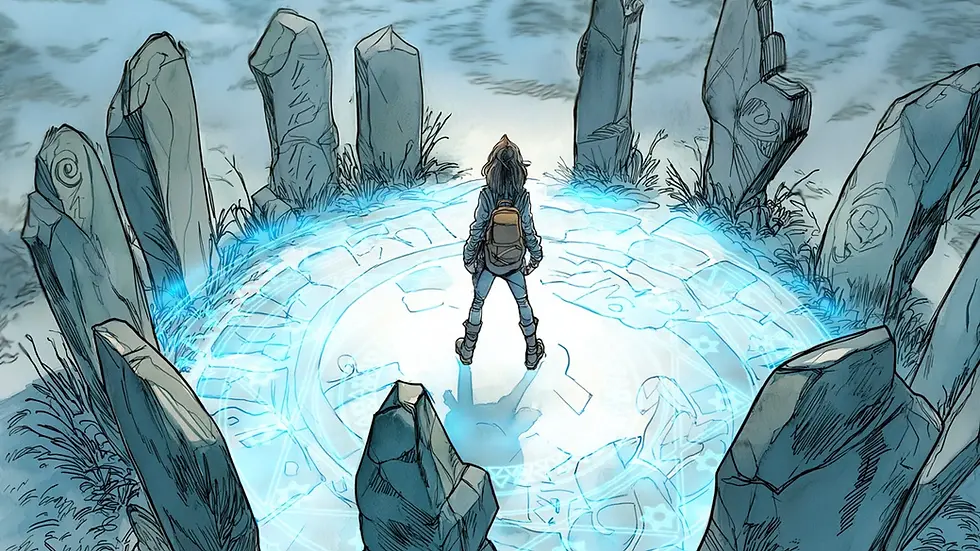Elysian House - The American Heart of the Supernatural & Paranormal Society
- Wrenegade Studios
- Aug 14
- 4 min read
“In this place, the veil is thin. The living and the dead do not meet by accident, but because the house itself calls them here.” Amelia Gabriel

In the heart of New Orleans’ Garden District stands Elysian House, an elegant white-columned mansion whose graceful verandas and sprawling gardens conceal more secrets than its neighbours could ever guess. The Supernatural & Paranormal Society chose it as their North American headquarters in the late nineteenth century, but its story begins decades earlier, when the house was nothing more than the lavish dream of a wealthy cotton merchant.
Built in the 1830s, the mansion was designed in the grand antebellum style, with towering columns, high-ceilinged rooms, and windows that welcomed the Louisiana light. Its gardens bloomed year-round, and its halls echoed with the sounds of New Orleans’ most celebrated gatherings. Yet, even in those early years, there were whispers about strange shadows in the corridors, cold drafts in the heat of summer, and unexplained noises in the night. Each new owner added to the building’s mystique, and by the late 1800s, Elysian House had become a local curiosity.
When the founders of the Supernatural & Paranormal Society, Albert Williams and John Alexander, set their sights on America, New Orleans was an obvious choice. The city was a crossroads of cultures, steeped in mysticism, folklore, and spiritual traditions from across the globe. In the early 1890s, they arrived from Europe fresh from exposing dozens of fraudulent psychics, intending to establish a base for genuine investigation. They soon heard of the mansion with its long history of strange happenings and decided to see it for themselves.
By the time they stepped through its wrought-iron gates, Amelia Gabriel had already arrived in the city. Amelia was one of the Society’s most gifted mediums and had played a pivotal role in shifting its focus from sceptical debunking to true investigation. She had been dreaming of Elysian House for months before setting foot in Louisiana. In her visions, the house appeared not merely as a building, but as a beacon. When she finally visited, she confirmed what she had suspected: the place was alive with an unusual and powerful spiritual energy.
During a private séance, Amelia made contact with a pre-Colonial spirit connected to the land itself, long before the mansion was ever built. This ancient presence told her that the house could serve as a meeting point for the worlds of the living and the dead. That revelation sealed the Society’s decision. In 1891, Elysian House became their North American headquarters.
The transformation of the mansion was both subtle and dramatic. From the street, it remained the same picture of Southern elegance. Inside, however, its grand halls were reimagined as research spaces and archives. Hidden rooms and reinforced vaults were built to contain dangerous artefacts and supernatural specimens. The walls were lined with protective wards and occult markings, invisible to most but unmistakable to those who knew how to look. Beneath the house, the vaults became the Society’s most closely guarded area, a place where entities could be safely studied. The once ornamental gardens were reshaped into sacred spaces for rituals, controlled experiments, and the occasional private gathering of trusted allies.
The mansion’s reputation as a beacon of paranormal activity grew quickly. Mediums, psychics, and occult scholars from across the Americas found their way to its gates, each hoping to work alongside the Society or to seek guidance. Strange lights in the upper windows, figures moving across the verandas after dark, and unexplained voices became familiar reports from both guests and neighbours. To the Society, these occurrences were not signs of danger but proof of the mansion’s unique role as a point of contact between worlds.
Elysian House’s location adds to its power. The surrounding Garden District is one of the most beautiful and storied parts of New Orleans, its streets shaded by ancient oaks draped in Spanish moss. These grand homes and iron fences hold generations of history, some of it far from peaceful. Only a short walk away lies Lafayette Cemetery No. 1, with its above-ground tombs and narrow paths where the dead seem almost within reach. The mighty Mississippi River flows nearby, long tied to local beliefs as a boundary between the living and the dead. Beyond the Garden District, the French Quarter hums with its own blend of revelry and ritual, voodoo shops standing alongside music halls, their energy mingling in ways that defy explanation.
Over the years, the Society’s work at Elysian House has uncovered countless stories, from tragic hauntings to benevolent guardians. It remains not only a centre of research but also a sanctuary for those who have experienced the unexplainable. Every creak of its staircases, every whisper in its shadowed halls, carries the weight of more than a century of investigation.
Today, Elysian House continues to stand as the beating heart of the Society’s work in North America. It is a place where history and the supernatural are woven together so tightly that they can never be separated. In the glow of the gas lamps along the garden path, it is easy to believe that the spirits of the past walk freely, watching as the investigators of the present carry on their work. As long as there are mysteries to solve and voices calling from the other side, Elysian House will remain a beacon in the dark, inviting the brave to step inside.
Uncover the Truth, Survive the Unknown.































Comments